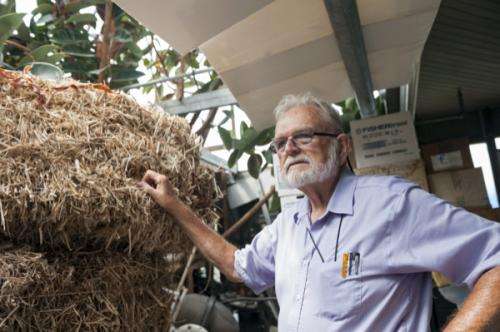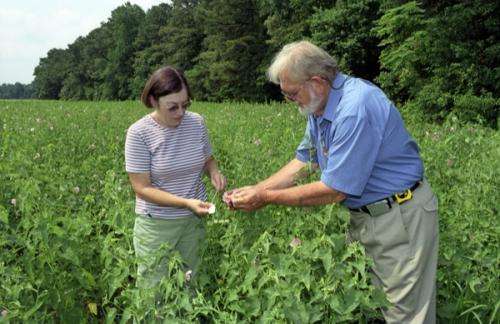Salt-tolerant crop shows promise as chicken bedding, helping farmers with flooded fields

Jack Gallagher grew up on a farm, but he never cared much for the squawking chickens pecking around. The Pennsylvania farm boy gravitated toward the coastline, where he built a career studying salt marsh vegetation as a marine scientist in the University of Delaware's College of Earth, Ocean, and Environment (CEOE).
Yet the professor emeritus of marine biosciences has returned to his agricultural roots, having found a potential new use for salt marsh plants: chicken bedding.
"I never thought I'd be involved with chickens," Gallagher said. "That's the exciting thing about research: You never know where it's going to lead."
With funding from Delaware Sea Grant and private supporters, Gallagher has long studied seashore mallow, a salt-tolerant, flowering plant found along the Atlantic and Gulf coasts. His research may end up helping not only chickens, but also farmers facing saltwater damage to their fields from worsening coastal flooding.
In a new partnership with UD Cooperative Extension, the Delaware Environmental Institute (DENIN), Delaware Wild Lands, CEOE, Delaware Sea Grant and others, Gallagher and his wife, retired CEOE research scientist Denise Seliskar, will help grow seashore mallow for testing as an alternative material for poultry house bedding.
The team will plant seashore mallow in areas where flooding has left soil salty and difficult to raise traditional crops like soybeans. According to recent estimates, sea level is rising rapidly in Delaware compared to the rest of the country, and up to 11 percent of the state's total land area may be inundated by the end of the century. Farmers' fields are already starting to flood more often, become inarable due to salinization and get taken over by invasive plants like Phragmites australis.
Gallagher initially began studying seashore mallow as a natural way to mitigate against such saltwater contamination. Seashore mallow can serve as a buffer plant against coastal flooding, with the plant fending off Phragmites and its deep root system fighting erosion. Seashore mallow is attractive for planting in new areas because it has large seeds that are easy to harvest and mechanically plant.
Gallagher and Seliskar planted two seashore mallow test plots about 10 years ago, one at UD's Hugh R. Sharp Campus and the other at a nearby family farm in Lewes, the latter of which was the first effort to scale a planting to use commercial farm equipment. Since then, they have investigated a multitude of uses for seashore mallow.

The seeds contain a high percentage of oil, making them a potential source for biodiesel feedstock—and the remaining seed meal usable as feed for cattle and fish. Other harvestable materials from seashore mallow include nectar for honey, thread for cloth and animal bedding.
"We've gotten a lot of different products out of the plant," Gallagher said.
The 2010 BP oil spill inspired a volunteer researcher in his lab to explore seashore mallow's absorbency, finding it to be effective at soaking up oil. Next, they and a U.S. Department of Agriculture partner in Illinois considered the plant as a base material for biodegradable kitty litter and hydromulch.
That sparked an idea among colleagues at UD.
"We started to say, 'Well, if it has potential as an animal bedding, could that animal be chickens?'" said Jennifer Volk, a CEOE graduate and extension specialist for environmental quality and management with Cooperative Extension, pointing out that the poultry industry is an important economic sector in the Delmarva Peninsula.
Volk, Gallagher, UD Cooperative Extension's Bill Brown and others will conduct a trial this spring, comparing seashore mallow bedding to pine shavings, the traditional material that has become increasingly costly and harder to find. They will also compare to two other bedding alternatives, Miscanthus and switchgrass.
The seashore mallow is chopped into roughly 1-inch pieces, making fluffy flakes to spread on the floor of poultry houses. The researchers will monitor the materials' absorbency and the health of the chickens over the course of the study.
At the request of Delaware Wild Lands, DENIN helped bring the various partners together for early meetings on the project. Two DENIN Environmental Scholars are helping with the project as interns: CEOE undergraduate Harry Colmorgen will map agricultural land vulnerable to Delaware Bay flooding, and Alfred Lerner College of Business and Economics student Andrew Flemming will work on land-use agreements with property owners in Kent County.
"This is a truly interdisciplinary kind of project," said Jeanette Miller, DENIN's associate director of interdisciplinary programs. "If farmers in Delaware are able to grow a native plant like seashore mallow as an alternative to crops that are no longer suited for salt-impacted agricultural land, that would be a huge boon."
With support from Delaware Sea Grant, the College of Agriculture and Natural Resources and additional grants, the project aims to plant 10 acres of seashore mallow by the spring of 2015. The team is looking at planted on land owned by Delaware Wild Lands.
In the process of the cross-University effort, Gallagher said he is finding himself interested to learn about the finer points of raising chickens. Bedding needs to sop away uric acid so the birds' feet do not get irritated, while also insulating them from the ground. The litter also can't be too dry, which can cause dehydration and respiratory illnesses.
It took a few decades, but the feathered flocks have started to grow on him.
"I like them better now," Gallagher said with a chuckle.
Provided by University of Delaware
















